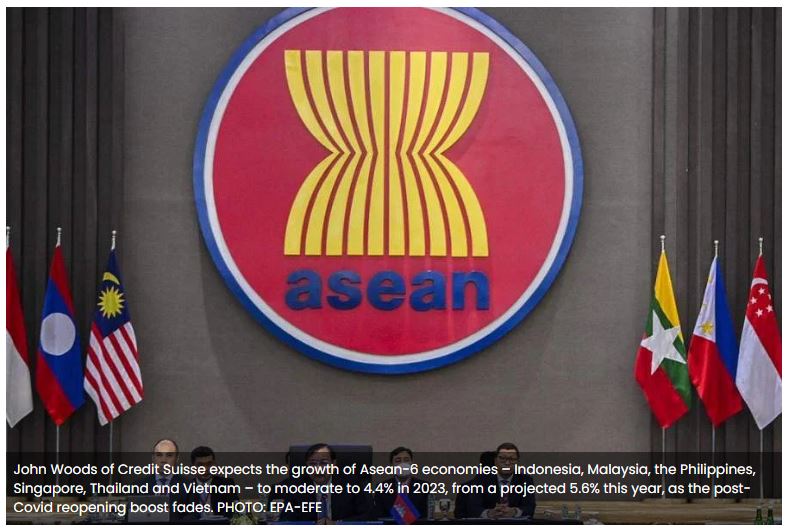Asean’s growth to slow in 2023, but region remains a bright spot in a slowing world
THE economic growth rate for South-east Asia may wane in 2023 amid intensifying global headwinds, but the region is likely to stay a bright spot in a world edging towards a recession, economists say.
John Woods, the chief investment officer (Asia-Pacific) at Credit Suisse, expects the growth of Asean-6 economies – Indonesia, Malaysia, the Philippines, Singapore, Thailand and Vietnam – to moderate to 4.4 per cent in 2023, from a projected 5.6 per cent this year, as the post-Covid reopening boost fades.
Commodities demand and the continued services recovery should provide some support to the economy, he added.
“In many respects, Asia will spend much of 2023 coming to terms with the economic and financial forces unleashed during 2022,” said Woods.
He shared that interest rate hikes by major global central banks will continue at least through the first quarter of 2023. This will put upward pressure on interest rates in the region, and currency volatility will remain high.
“Consequently, the economic growth rates for Asia are likely to slow, although I anticipate that they will stabilise towards the end of the year,” he said, adding that investors should remain wary of risk assets, including those in Asia.
Andrew Tilton, the chief Asia-Pacific economist at Goldman Sachs, estimates growth to slow with a significant sequential deceleration through the first half of 2023.
Key drags are a fading reopening boost as most economies emerge from the Covid-19 restrictions; a global growth slowdown to 1.8 per cent in 2023, from an estimated 2.9 per cent this year; a tech cycle downturn; tighter financial conditions; and the impact of higher inflation and higher rates on household incomes and interest-rate sensitive sectors.
The small and open economies of Singapore and Malaysia will likely slow the most owing to their linkages to global growth and the tech cycle, Tilton said.
After two years of above-trend growth, Singapore’s real gross domestic product (GDP) growth is expected to slow to 1.5 per cent next year, as global headwinds weigh on the city-state’s externally-oriented sectors, which account for 55-60 per cent of its total domestic value-add.
“Overall, external-oriented sectors are likely to underperform, pulling growth momentum lower until the first half of 2023, with some recovery thereafter. A bigger tightening in global financial conditions and a global growth slowdown are key downside risks to the outlook,” Tilton said.
Malaysia’s real GDP growth is seen slowing to 4 per cent in 2023, down from a projected 9.2 per cent this year. While global trade-related sectors underperform, domestic spending, especially consumption, could stay more resilient, underpinned by sturdy employment gains and government subsidies.
Rising tourism revenues could also provide some offset to a global slowdown.
GDP growth in Indonesia is projected to slow to 4.4 per cent in 2023, from an estimated 5.2 per cent this year. Goldman’s economist said Indonesia’s terms of trade boost is unlikely to be as large as in 2022 as commodity prices stabilise.
Real household spending growth is also likely to slow modestly, as nominal wages struggle to keep pace with higher inflation and saving rates remain depressed relative to pre-Covid levels. Decelerating global growth and tighter financial conditions will likely also weigh on private investment spending, albeit to a smaller extent than previous cycles in Indonesia.
Goldman’s portfolio strategists recently downgraded Indonesian equity markets to market-weight, from overweight previously, as allocations could shift back to a North Asian focus, but still expect some equity inflows to the country.
As for the Philippines, its real GDP growth could moderate to 5.8 per cent in 2023, from an estimated 7.2 per cent this year, as policy tightens and the government cuts capital expenditure spending.
Thailand may be the only economy in South-east Asia that bucks the deceleration trend, backed by ongoing tourism improvements, lower global shipping costs and a diminishing commodities drag, Tilton said.
Its real GDP is seen growing by 4 per cent in 2023, from a projected 3.5 per cent in 2022. The boost is likely to come from the ongoing revival in international travel, a significant normalisation in international shipping costs, and a smaller drag from commodity prices, with some offset from tighter policy and higher inflation.
Tourist arrivals in Thailand could increase to 25 million in 2023, from about 10 million this year, with the tourism rebound contributing around three percentage points more to GDP growth than in 2022.
Over in Vietnam, Goldman is expecting “below-potential” growth there. Real GDP growth in 2023 is forecast at 5.8 per cent, down from its 2022 forecast of 7 per cent growth.
The Wall Street investment bank said of Vietnam’s prospects: “Moderation in domestic demand accounts for most of the growth slowdown throughout the year, with a slump in external demand further weighing on growth momentum early in (2023)”.
Trinh Nguyen, a senior economist for emerging Asia at Natixis Corporate and Investment Banking, said that even with a cyclical downturn expected in 2023, South-east Asia is emerging as “both a winner and a prize in the geopolitical contest for investment and trade”.
Source: https://www.businesstimes.com.sg/international/asean/aseans-growth-slow-2023-region-remains-bright-spot-slowing-world


 Thailand
Thailand




